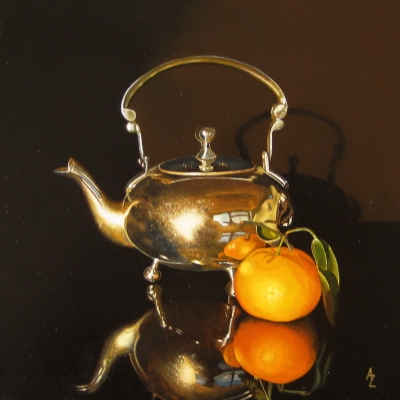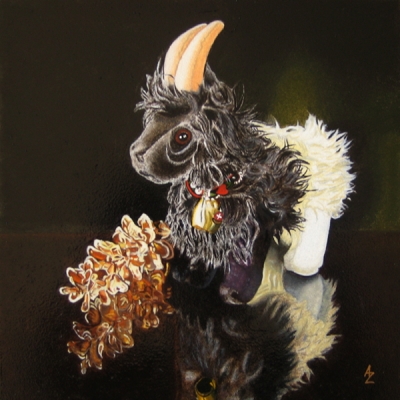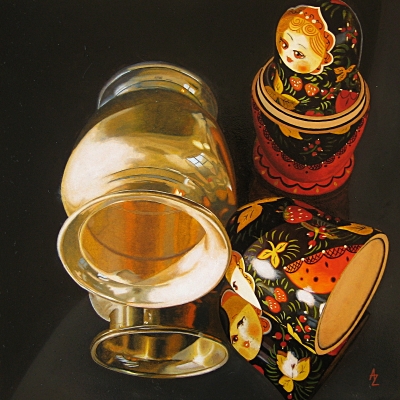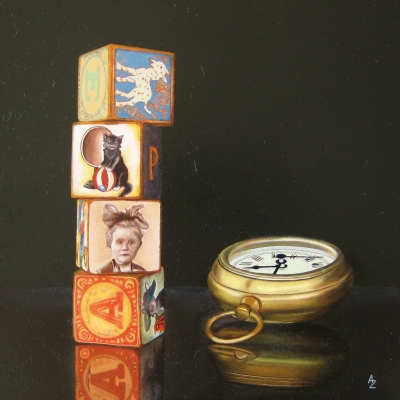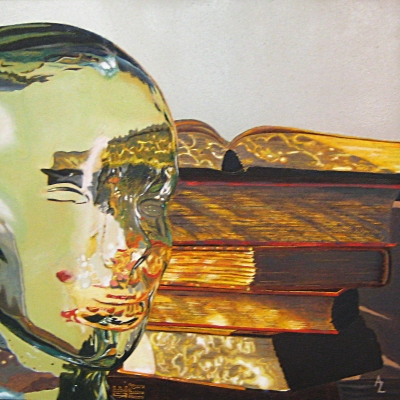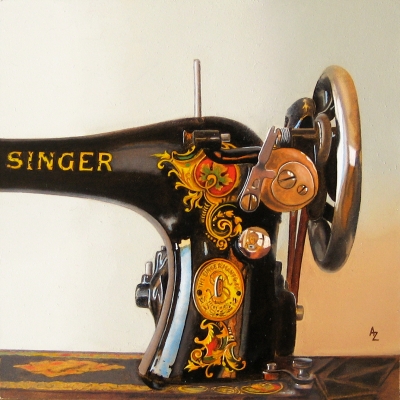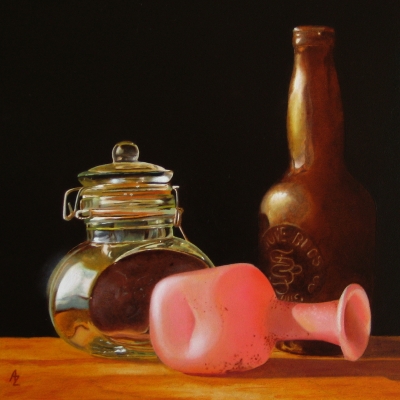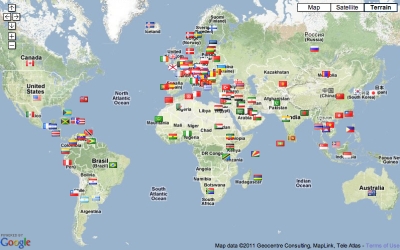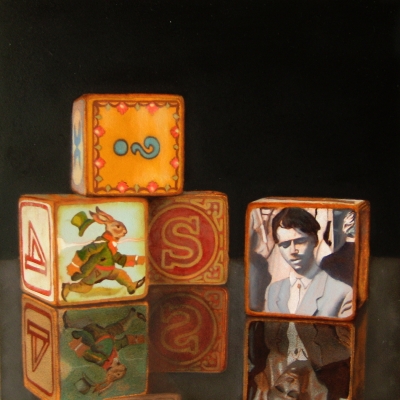Posts in Category: oil
Make Tea not War
6″ x 6″ (15 x 15 cm) oil on gessobord panel.
I am a tea buff, as in tea aficionado, tea connoisseur, but otherwise known as a tea snob. In our little tea universe we study and admire tastes, aromas and colors. We understand tea terminology, geography and pedigree. We frown at shredded tea leaf or added flavors. We are purists who mail our precious tea leaves from their countries of origin. Among us tea bags are an insult and Lipton is a dirty word. You get the picture. I am not gone that far on this tea road, but far enough to bring my tea with me when I travel.
And of course we admire teaware. Teaware is an art form in itself, many collect teaware, which can run up astronomical prices for historical and rare pieces. I am not a collector, but I have a few teapots. Different teas require different pots to bring out full flavor.
This little painting is of my silver teapot from England. Not particularly old or historically significant, but it is pretty and I like it for Ceylons or Darjeelings. There is no deeper meaning here, I just wanted to paint a silver teapot. Check out the multiple reflections of the clementine! And because it is an simple painting I thought a line from Monty Python is particularly suited for the title.
Eiger Trail
6″ x 6″ (15 x 15 cm) oil on gessobord panel.
In the year 2000 my husband and I went to Switzerland and did some wonderful mountain hiking. The absolutely amazing experience was the Eiger Trail near Gimmelwald. I was completely spellbound with its majestic beauty. So much so that I even bought a local souvenir (which I never do, btw) – a local goat toy. These goats are the funniest critters – black in the front, white in the back, curious and fearless creatures. This still life is another one in the Reflections series I am working on.
A few days ago my friend and artist Carol King (Carol King blog) asked about process and steps it takes me to paint these still lives. An excellent question that I promised to answer.
My process:
I usually start with an idea. The idea can be visual – color I like, line that is intriguing, texture I haven’t tried before. Or it can be intellectual – memories, poetry, or emotions that touched me. This idea brings forward objects that could express it. I often have to hunt for these objects in thrift stores or borrow them from my friends and family – sorry, guys!
I make numerous compositions from objects I assembled and experiment with light. Following Norman Rockwell’s methods I take dozens of photos of my various setups in various lights.
Bringing the photos to my computer I sort and discard. With the remaining few I work on crop and composition. Half the time I can’t get an image that satisfies, and when this happens I go back to playing with my objects and light and camera.
Once I have a composition I like, I draw it in pencil. I often use grid method working from my computer screen and make my drawing as accurate as I can. At this stage I make decisions about details and routinely skip and omit portions that I don’t want in a future painting.
I rub the back of the drawing with vine charcoal creating a transfer surface and transfer the image onto the gessobord. Gessobord by Ampersand is my preferred surface because it is very smooth. The transferred charcoal image gets corrected and then fixed with Krylon fixative.
When fixative is dry I put in an imprimatura layer. I like my paintings to have warmth coming from within, so my usual imprimatura is done in yellow ochre or burnt sienna or burnt umber or a combination of them.
I use Gamblin oils, Gamsol for solvent, and Galkyd Slow Dry medium. Here is the list of my colors:
- yellow ochre
- burnt sienna
- burnt umber
- alizarin crimson
- venetian red
- cadmium red light
- cadmium yellow light
- cadmium yellow medium
- cadmium orange
- viridian
- ultramarine blue
- cerulean blue
- payne’s grey
- portland grey
- ivory black
I use two whites – titanium and flake white.
I would give you my preferred brushes too, except I don’t have them. I have many brushes I use and dislike to various degrees, some more and some less. But I haven’t found brushes that would do what I want without a struggle. I will write about brushes in another post.
I use several sources as references for painting. I paint from the laptop screen, which is very convenient because I can enlarge details and lighten darks to see better. And I use a printed reference, which is convenient in a different way because I can rotate it. I also have my objects present so I can see the real colors.
I wait until my imprimatura layer is dry and begin the background. I usually work background to foreground and dark to light. The difficulty starts when my background is light and foreground is dark. In this case I abandon reason and work easy passages first and difficult ones later.
I let the background dry overnight. I prefer it to be reasonably dry, but it is not a must. If it is still tacky next day, I begin painting my foreground composition anyway using a painting bridge.
It usually takes several days to paint the first color layer. When the first layer is dry to touch I often do a coat of retouch varnish to even up sunken colors and assess where I am.
Then I do the second color layer, correcting, deepening, creating variations, adding details and brightening highlights. I may use Galkyd medium in the second layer.
Second layer complete I add another coat of retouch varnish and assess again. Often at this stage the painting begins to speak to me, telling me it is time to round things up. When I hear that, I correct mistakes I can find and get out my “Finishing a Painting Checklist.”
Reading books, blogs, talking to painters and making paintings myself I compiled a list of things to check at the final stages of a paining. I go through it and check and correct things. But it is not as analytical as it sounds. Sometimes I see something that needs changing according to my list, but I like it the way it is and leave it. In fact, I disregard a lot of rules, some of them rather fundamental.
Against well known and well established rules:
- I paint flat on a table
- I use small, smaller and smallest brushes
- I love details and paint a lot of them
And I am unrepentant and unapologetic.
I sign my small paintings with initials only. When a painting is sold or goes to a show I add a label in the back with a title, media, my full name, and year painted.
I let my small oils dry for at least a week before I varnish them. I use Gamvar varnish applied with a brush.
A Dream within a Dream
8″ x 8″ (20 x 20 cm) oil on gessobord panel. To bid on this painting click here.
The painting was slow in coming, and I am not all sure why it took so long. I started it before Christmas. So OK, there was Christmas with all its Christmasy chores, then there was the New Year and a pressure to party, then Shelly went on her epic Israeli trip. Where did the time go…
I am doing a small series under a working title Reflections. The idea is to connect memories with images reflecting in a mirror. I am working on another painting along these lines that is nearly finished.
In this one I hoped to connect to my former country. I tried to work out the anger I still feel even now, almost a quarter of century since I left. When I try to be rational I can come up with things that were good back then, 25 years ago, but list is rather short. I remember being young was fun, ahh… good times we had! Love Russian art, poetry, and music. Hmmm… love how mathematics was taught… Love my memories of hiking, sailing and amazing natural beauty. That’s about it. My other list – the “angry” one – is long and ugly, full of injustice, KGB and empty grocery stores.
The credit for the title of this painting goes to my daughter Shelly. Thank you, Shelly, it was brilliant!
BFFs
Best Friends Forever… Katya and Colin.
8″ x 8″ (20 x 20 cm) oil on gessobord panel. To bid on this painting click here.
In spite her youthful appearance Katya is an old gal. She is 19, almost 20. We all remember vividly how Katya came to live with us. That summer Shelly was 3 and had to go see her doctor for a checkup. For some unfathomable or since forgotten reason the doc decided that Shelly’s ears needed to be washed inside with warm water applied from a large syringe. Shelly took exception to the proceedings. Her wailing could have drowned an ambulance siren. She was still voicing her objections and indignation when we left the torture chamber, I mean – the doctor’s office, and got in a car. Instead of going home I drove straight to Toys-R-Us. Grandma and I knew that we found a soul mate as soon as we saw Katya. The drama and tears stopped in an instant, and Shelly was smiling. Katya lived with us ever since and helped us through many illnesses and medical procedures.
Colin came much later. My memory of Shelly’s early teen years is fairly vague. I understand that the psyche does this for a reason, for our own benefit some things better remain obscured and misted over. I don’t object. But at some point during those fog clouded years Colin arrived and took a place of honor on the bed, next to Katya and Francisco.
Oh, should I tell you about Francisco? Later, perhaps… when I paint him.
Memory Blocks III
A new installment for my Memory Blocks series. This time it is with my mom’s portrait at the age of 5.
8″ x 8″ (20 x 20 cm) oil on gessobord panel. To bid on this painting click here.
I’ve found interesting articles about photorealism and hyperrealism on Wikipedia:
Photorealism
Hyperrealism.
While the articles are very informative, with lots of links, examples and images, they didn’t articulate clearly the difference between the two styles. Seeing that the terms are often used interchangeably I wanted to define the deference for myself. Here’s what I came up with:
The beginnings of Photorealism are placed at 1960 – 1970. It is a method of painting that uses a photograph as a reference and takes this reference literally. The painted image is extremely well defined and detailed. All information available about the subject is rendered in the painting. The rendering is tight and very accurate. Emotional processing and creating of a narrative are left to the viewer’s imagination.
It was clear from the articles above that Hyperrealism as a genre has originated in Photorealism at about 2000. In difference to its originating genre Hyperrealism takes the image to a surreal plain to some extent. The painter paints everything he or she sees to the maximum degree of accuracy that the skill and medium allows… and then the artist takes the image further, creating more clarity and definition than the reference had. For example, if some details were dimmed in a shadow or bleached in a strong light, the artist reinvents them and puts them in. The resulting image simulates a reality that did not exist and crosses into the territory of illusion.
Clarity
As if one empty head was not enough, I got myself another. I came across this glass mannequin head – which is supposed to be a hat holder – in Pier I and had to have it. And paint it. I hear “two heads are better than one” everywhere, so maybe there is hope.
The glass head is life size, and I paired it with a stack of old books – the ultimate clarity. I couldn’t resist the distortions and play of light the glass creates. The title – Clarity – is of course a play of words and a bit of a mockery: the resulting painting, while rendered in realistic tradition, contains surprisingly abstract shapes and patterns.
6″ x 6″ (15 x 15 cm) oil on gessobord panel. To participate in an auction and perhaps acquire an empty head for yourself 🙂 – click here.
![]()
Singer
I had this magnificent old Singer forever. So long that I don’t even remember where it came from. I think I found it in the basement of the house I bought 20 years ago, but i can’t be certain. The house is long sold and forgotten, but I kept the sewing machine – what an amazing piece of design! They literally don’t make them like this any more.
This particular Singer numbered G9848954 – Model 127 “vibrating shuttle”(long bobbin) – was built in USA between 1921 and 1923 according to the records meticulously kept by Singer Manufacturing Co. Probably closer to the end of the range judging by its number. The machine still works, but I have a new contemporary electric Singer for what little sewing I do these days. This one is to admire and paint. A piece of history.
6″ x 6″ (15 x 15 cm) oil on gessobord panel.
Handle with Care
A brand new clear jar from Whole Foods, an old brown bottle found on a construction site and a Murano glass vase from Venice – a delightful glass world. I must be part crow – I love glass! Now that I don’t weave with glass, I paint it, just can’t keep away from it. The play of light in glass enchants me.
6″ x 6″ (15 x 15 cm) oil on gessobord panel. To buy this painting click here.
On September 6 this blog Pencil Scribbles turned two years old! I briefly thought of doing a separate post about it, but it didn’t seem important enough for a dedicated post. But it does deserve a mention. During its two years
29 213 times people viewed something on these pages
1267 comments were left
115 different countries visited and left a flag on my map
106 times I made a piece of art or had something to say!
Here’s to you, my friends – old and new!
Memory Blocks II
Just finished another Memory Blocks painting. The block on the right is my father Shimon circa 1961 or thereabouts. I have to ask him when exactly this photo was taken. These blocks are a blast to paint. I made them new and shiny at first, then aged them and felt like a Master of Time.
6″ x 6″ (15 x 15 cm) oil on gessobord panel
Le Gallery Thorndale
Today I took these six paintings to their first show at Le Gallery Thorndale. Le Gallery Thorndale is a local gallery sponsored by Chicago Edgewater Chamber of Commerce.
From gallery’s press release:
Le Gallery Thorndale is a limited-time, exclusive art exhibit organized by Edgewater Artists in Motion as part of its ongoing effort to make Chicagoans explore Edgewater as an eclectic artistic community and a vibrant creative force in our city.
Location: 1106 West Thorndale Ave, Chicago IL 60660
Opening: Friday September 2, 5:30 – 8:30 pm
Show dates: September 2 – September 30
Gallery Hours: Friday – 4 pm to 7 pm, Sat and Sun – 11 am to 4 pm
If you are in Chicago, join me, other artists and art collectors for the opening night on Friday, September 2, 5:30 – 8:30 pm.

